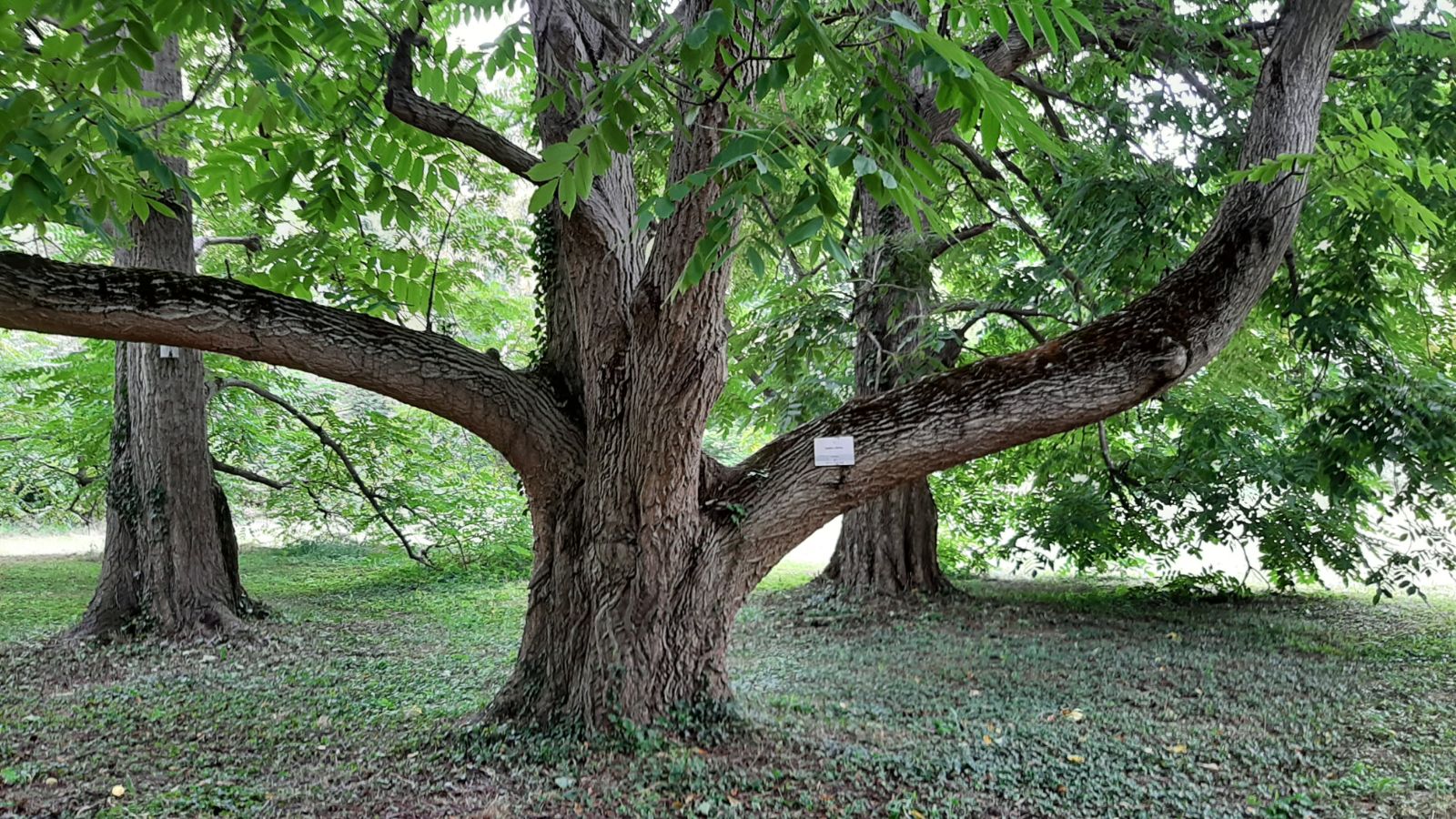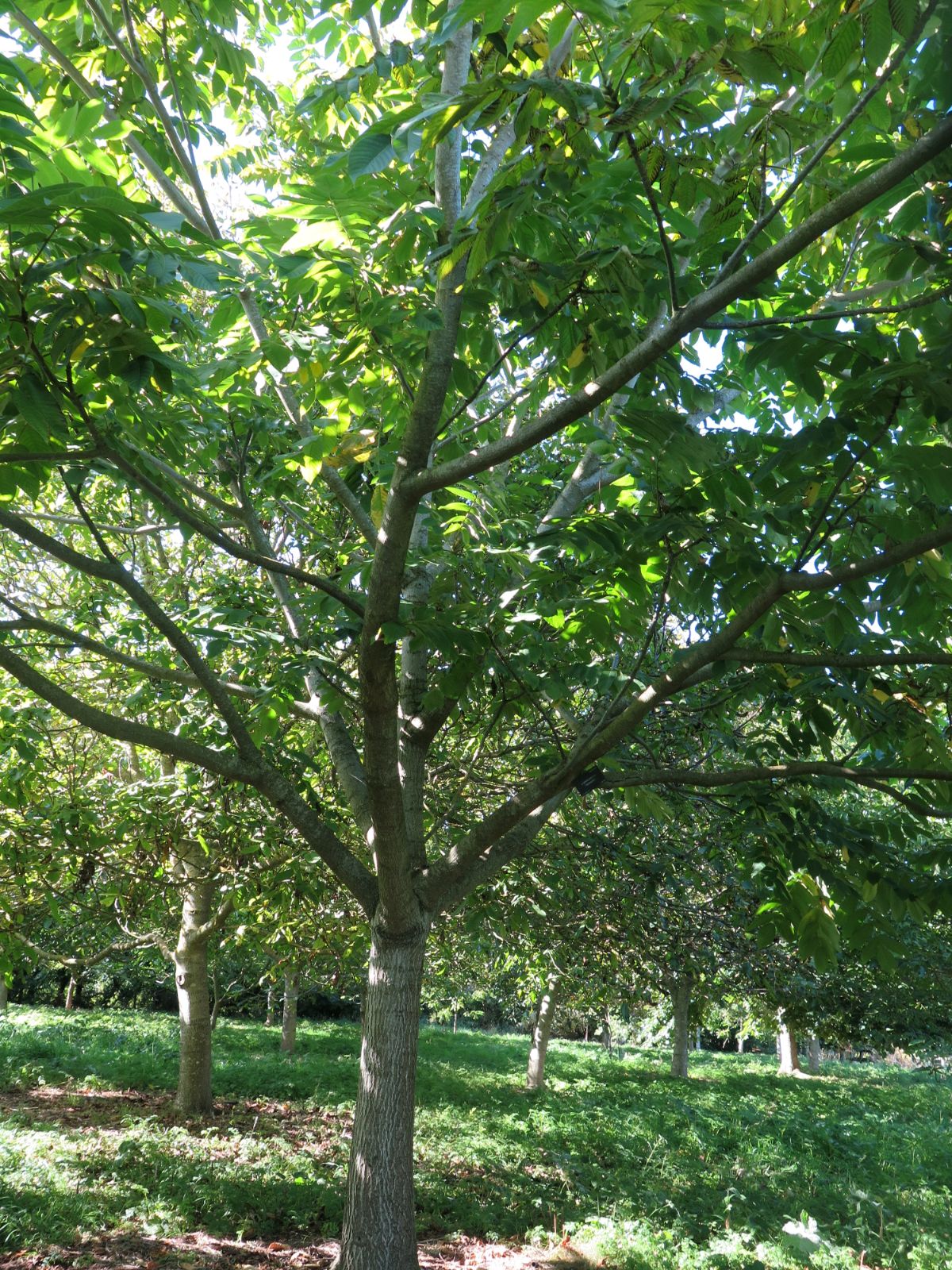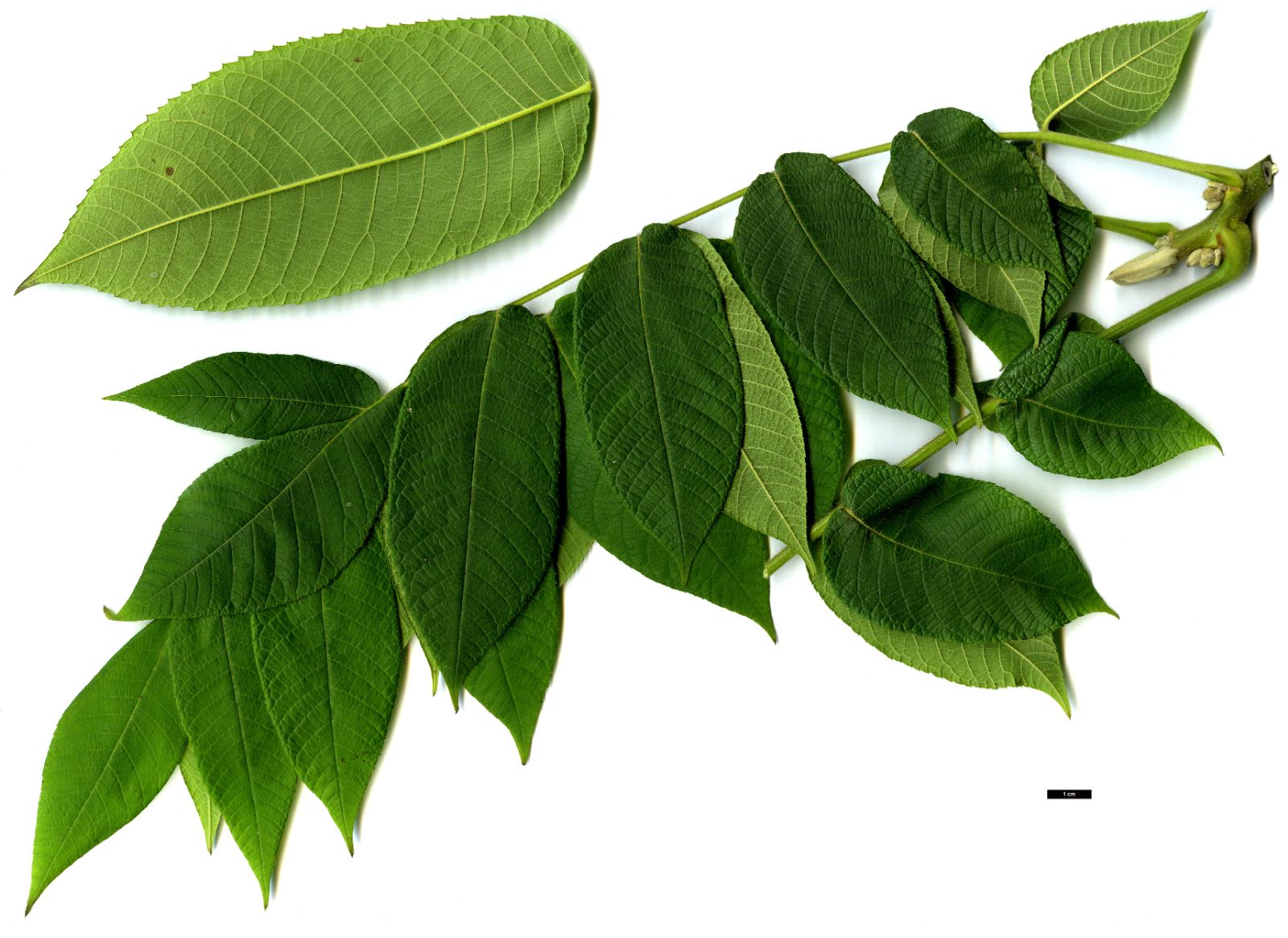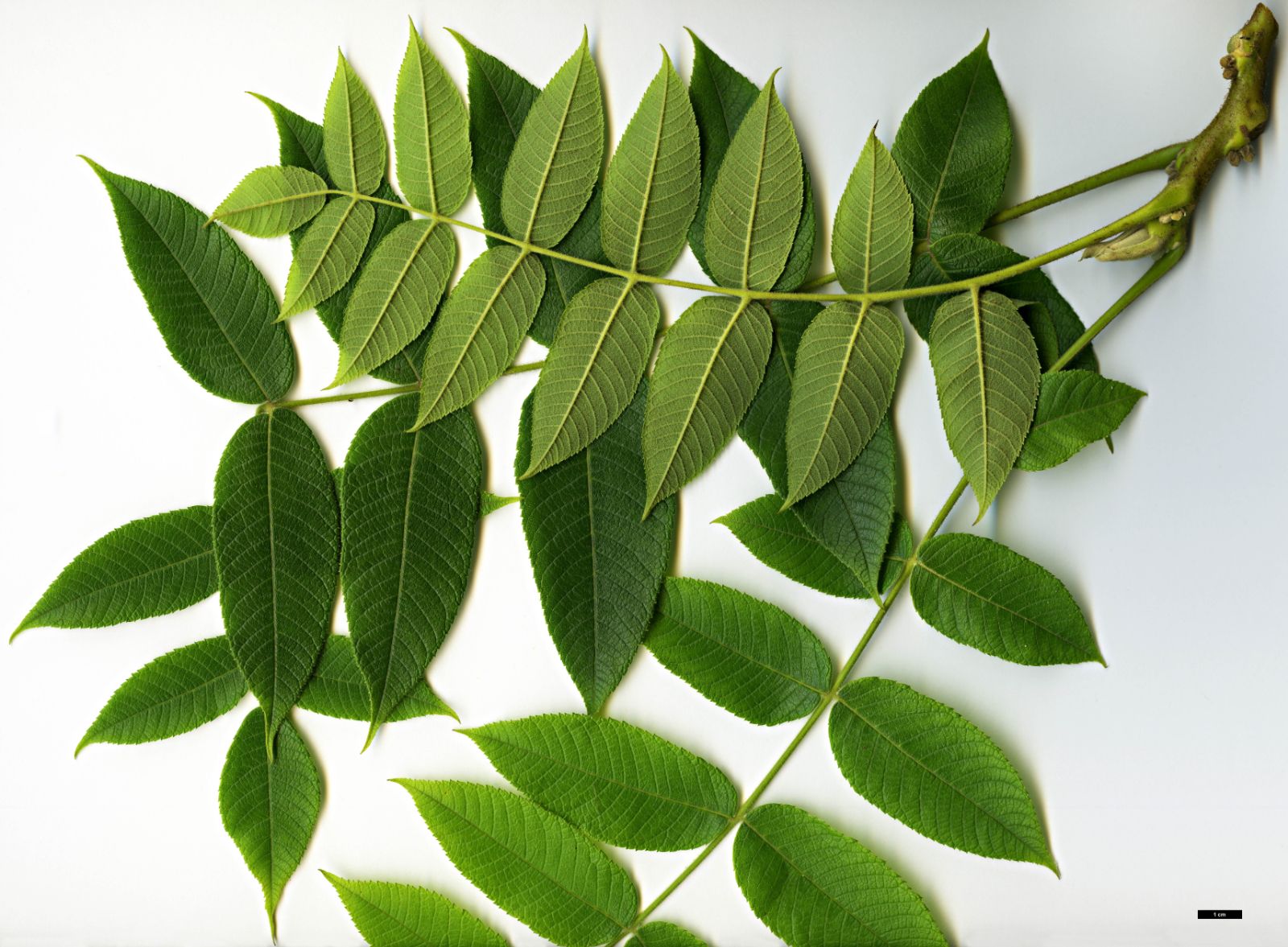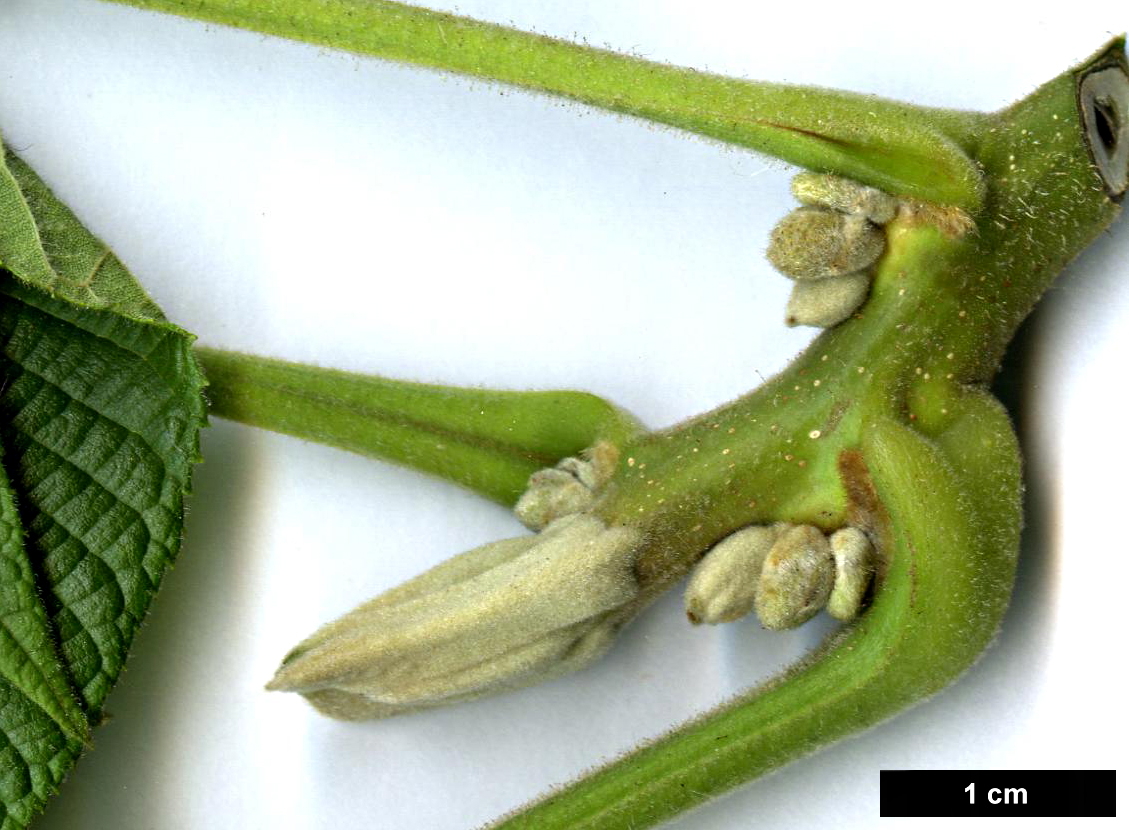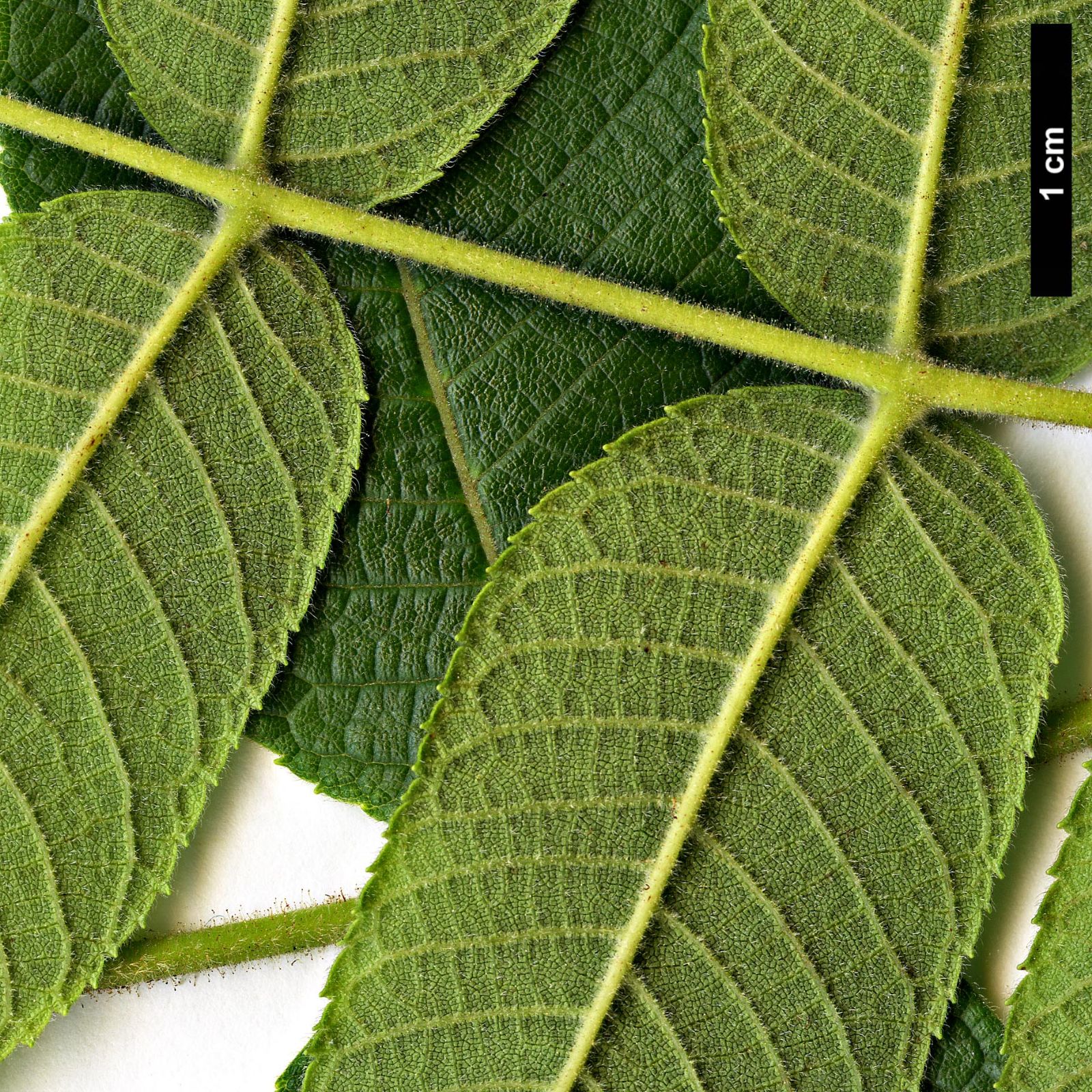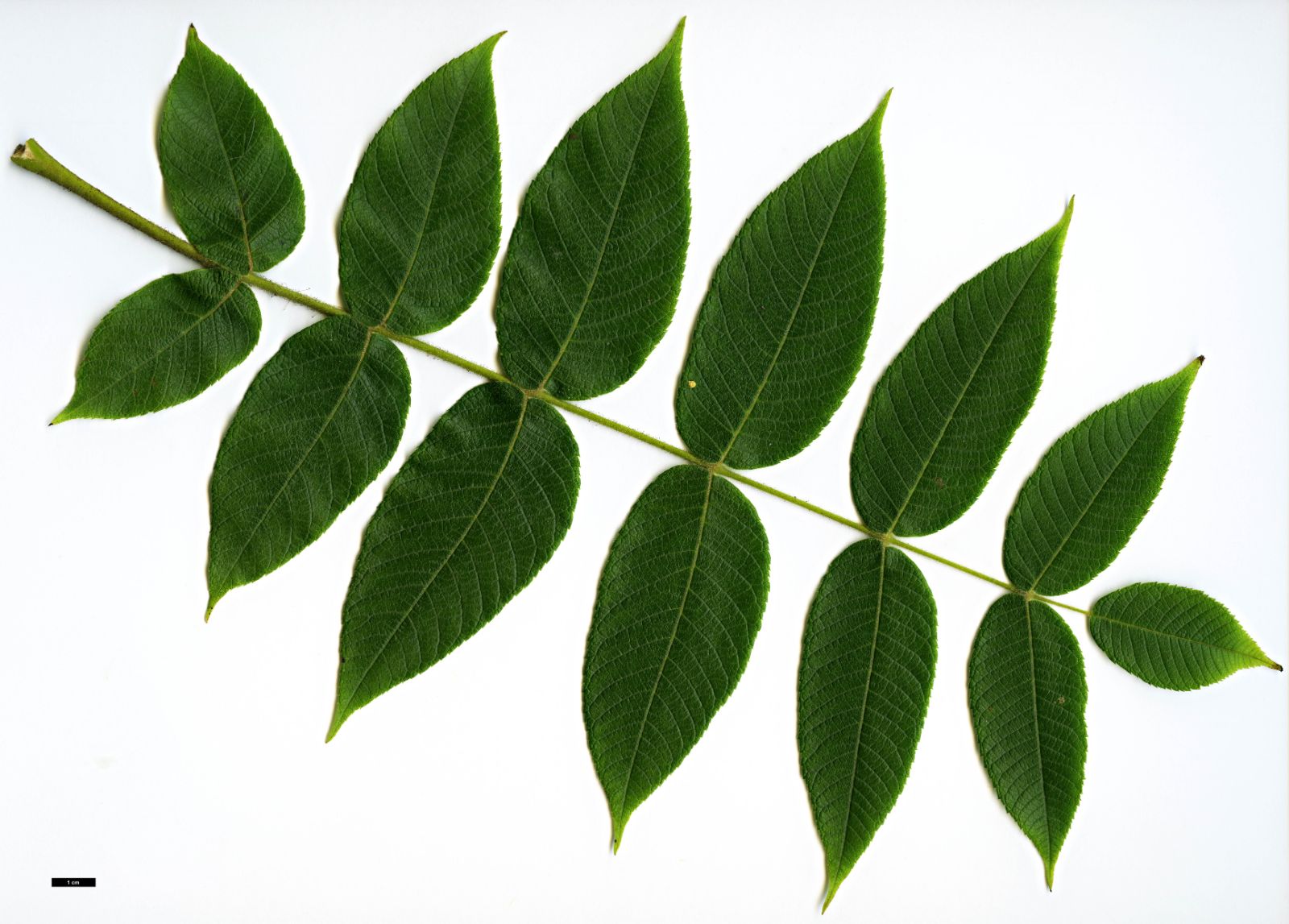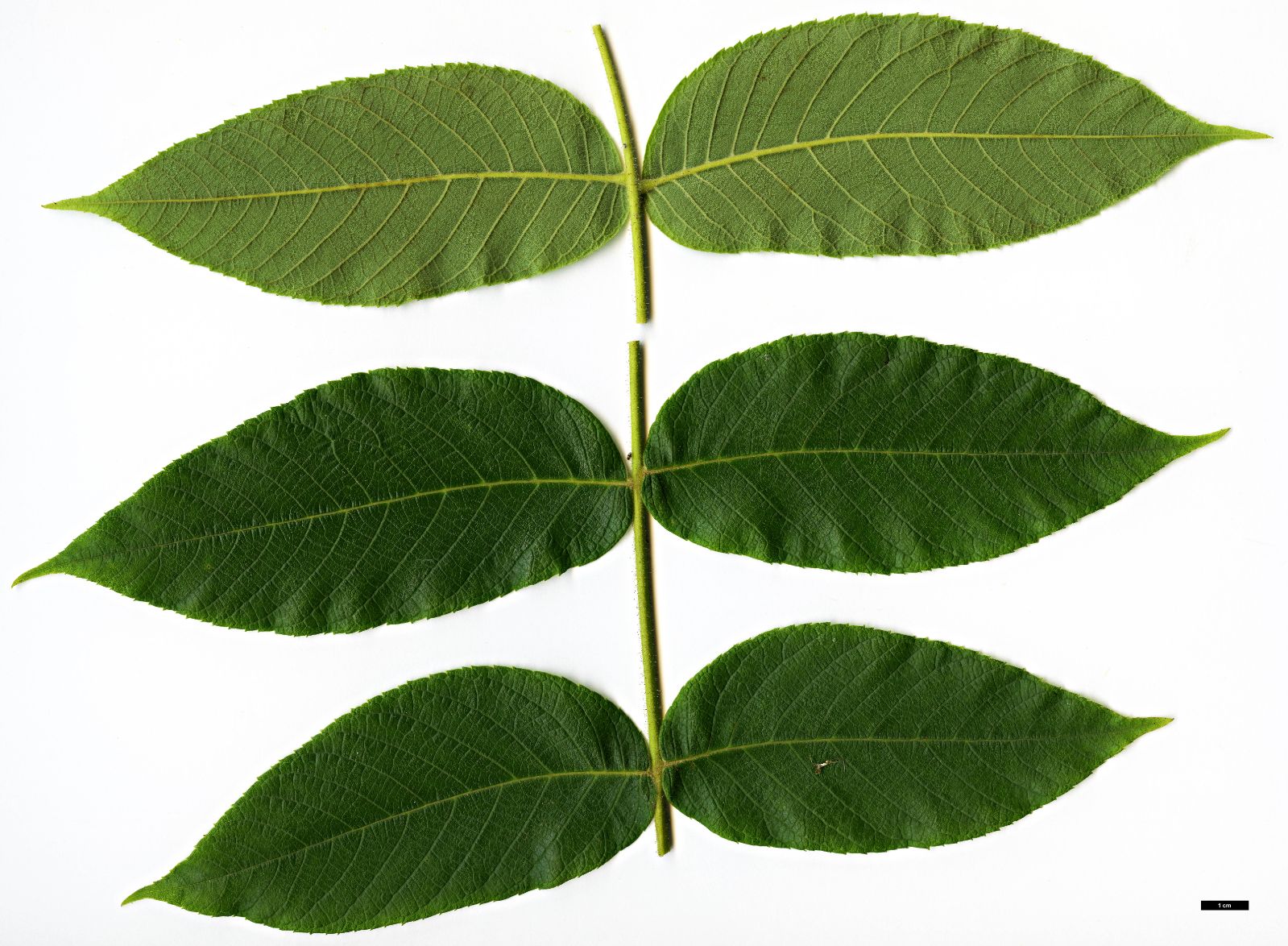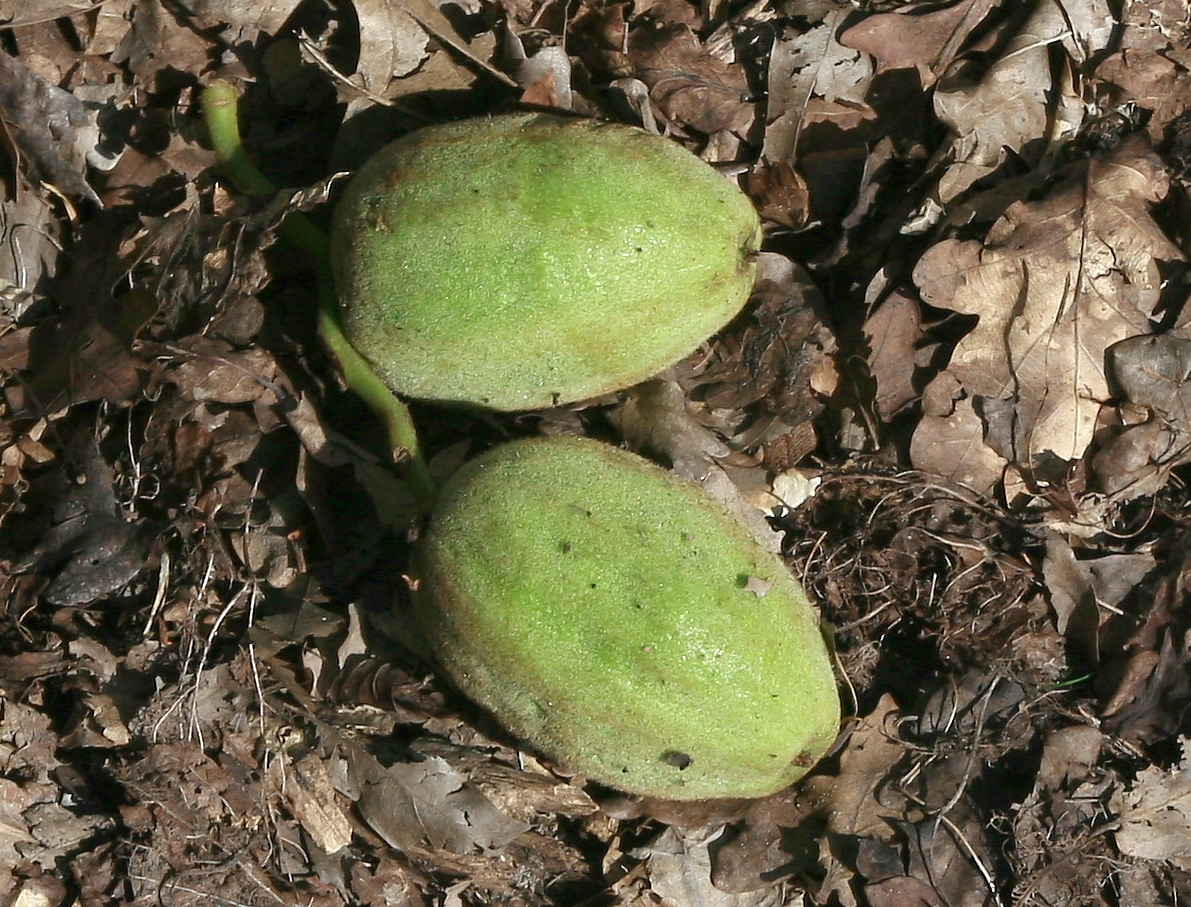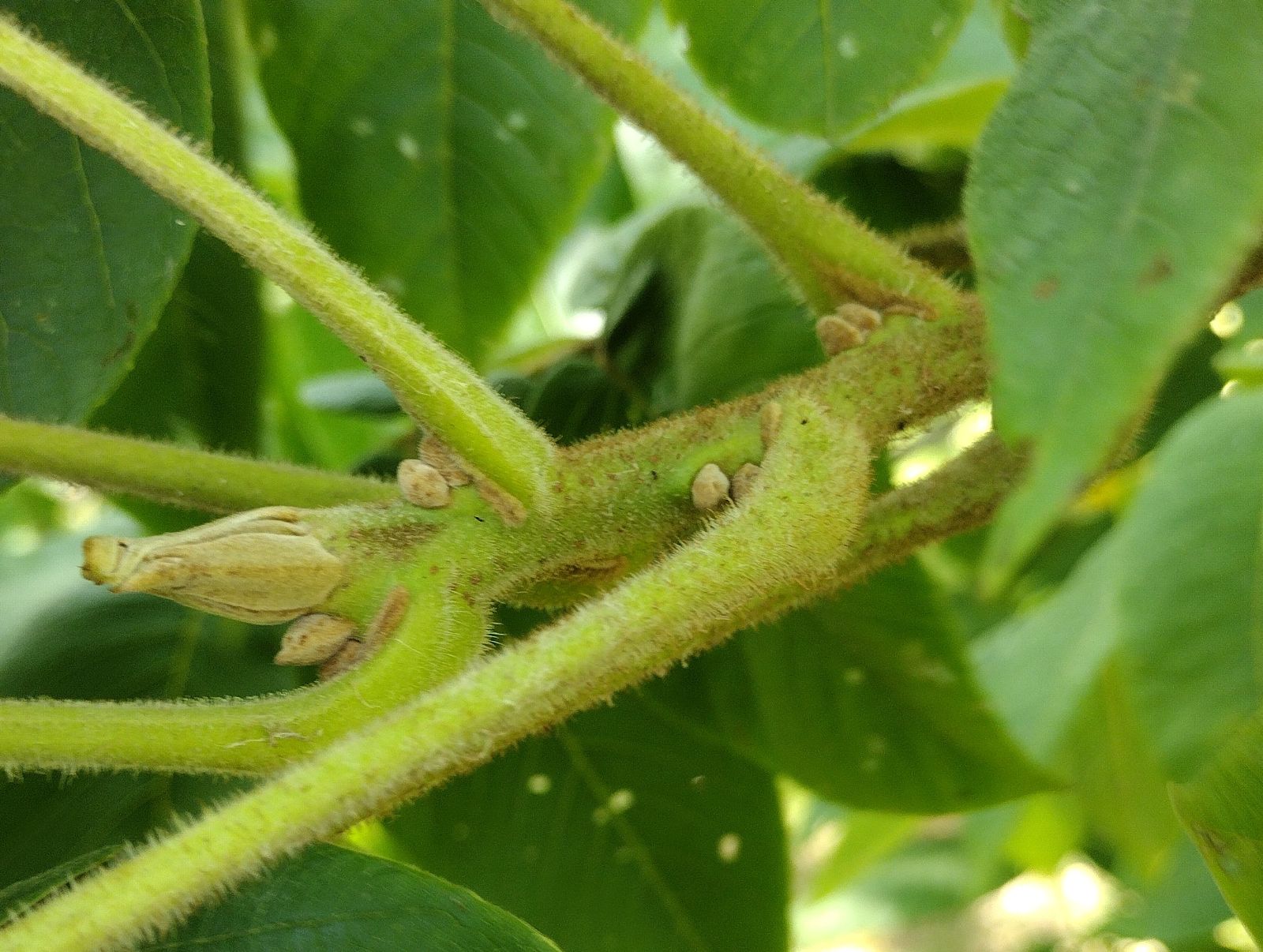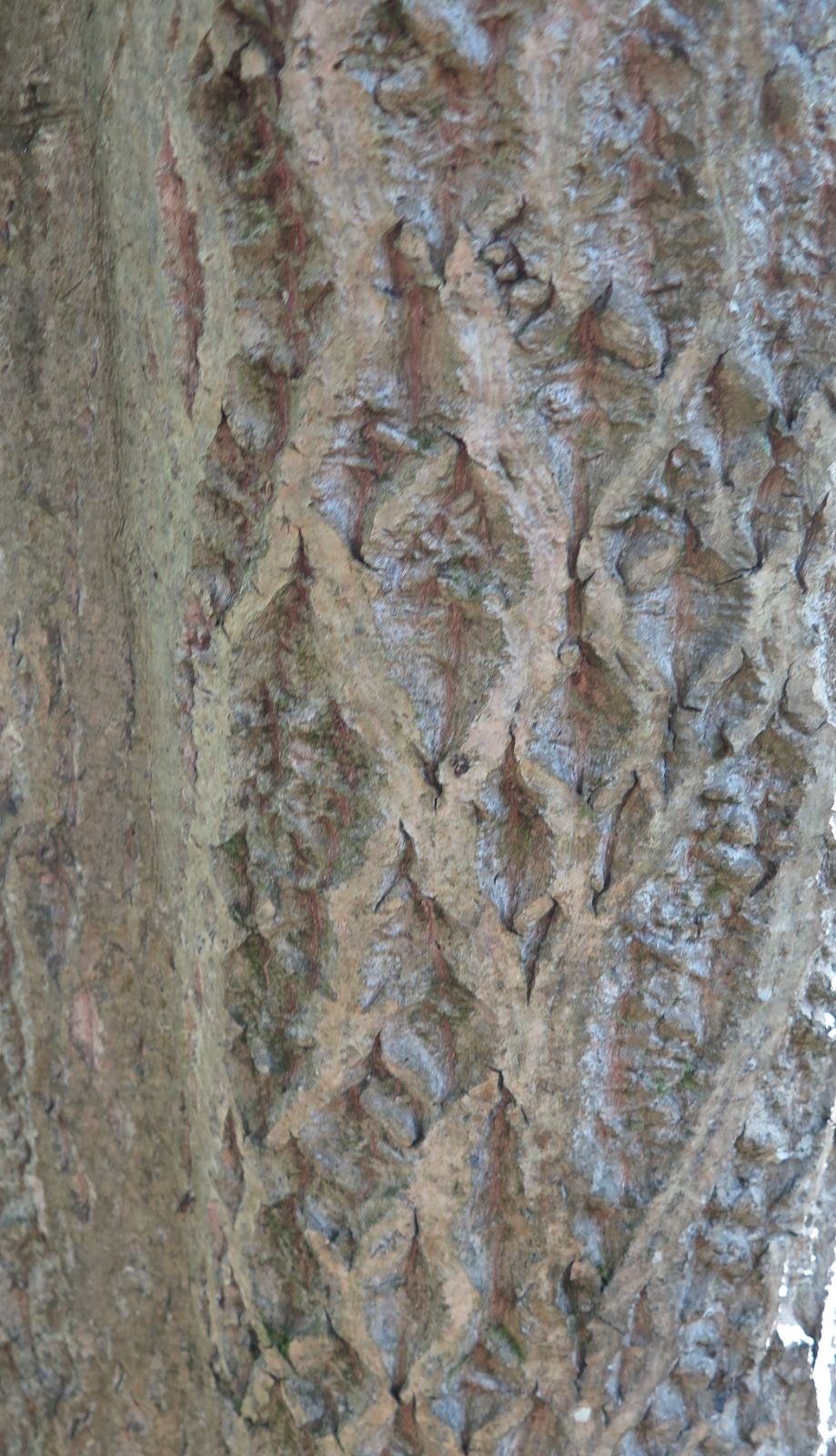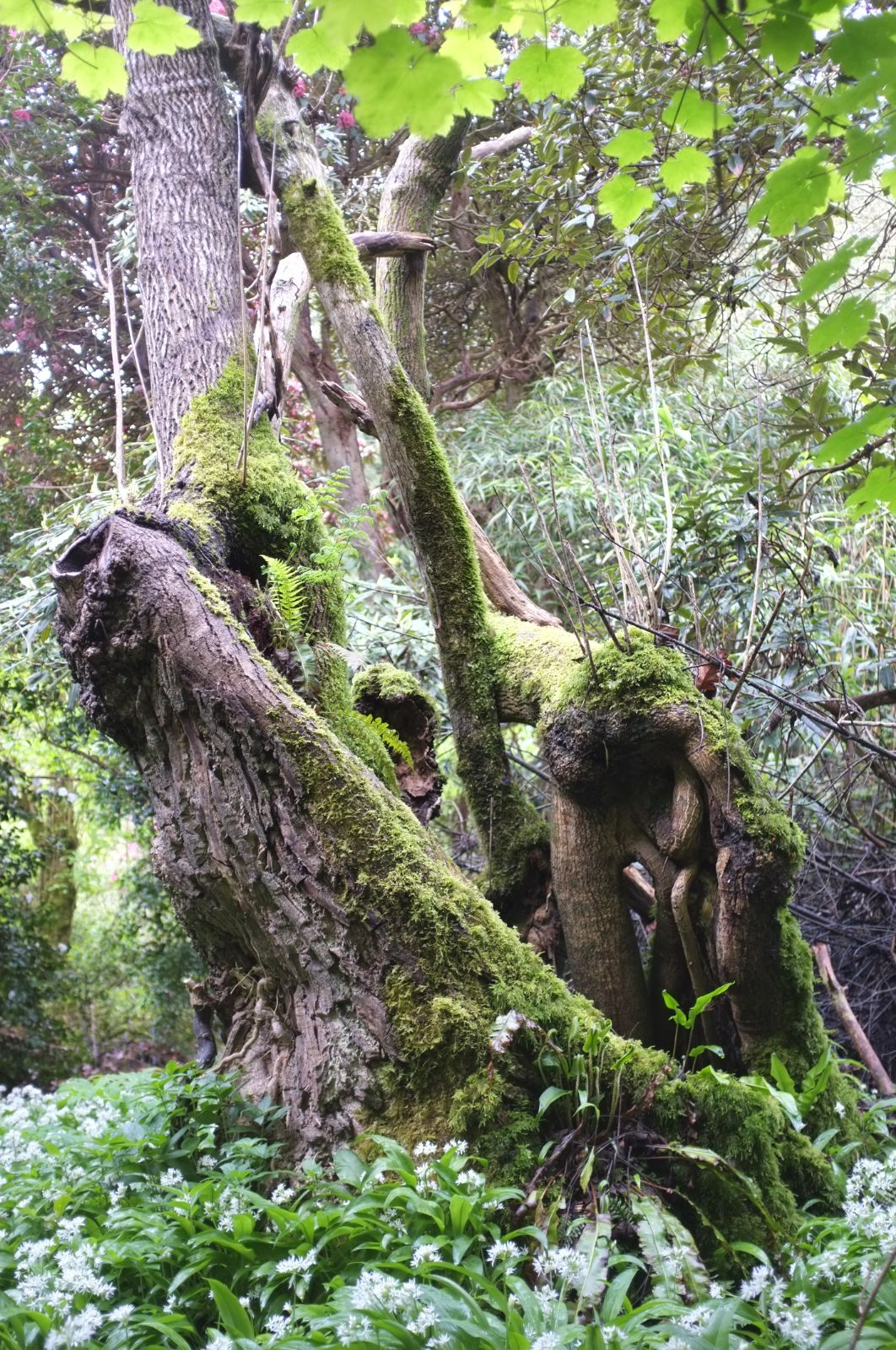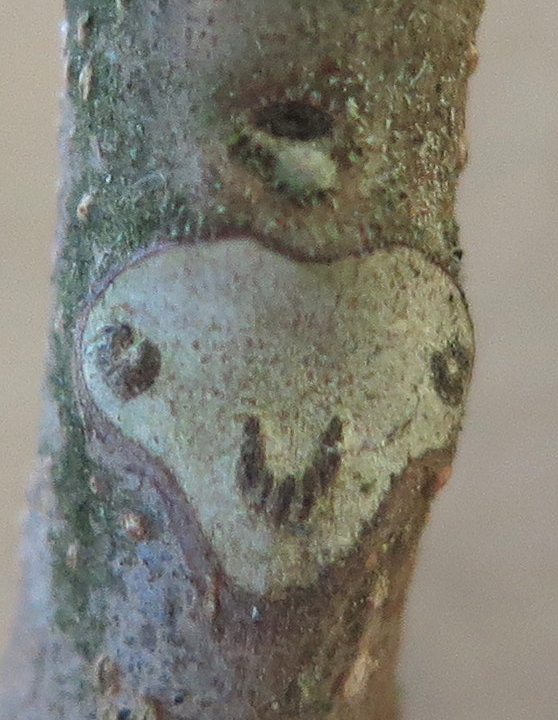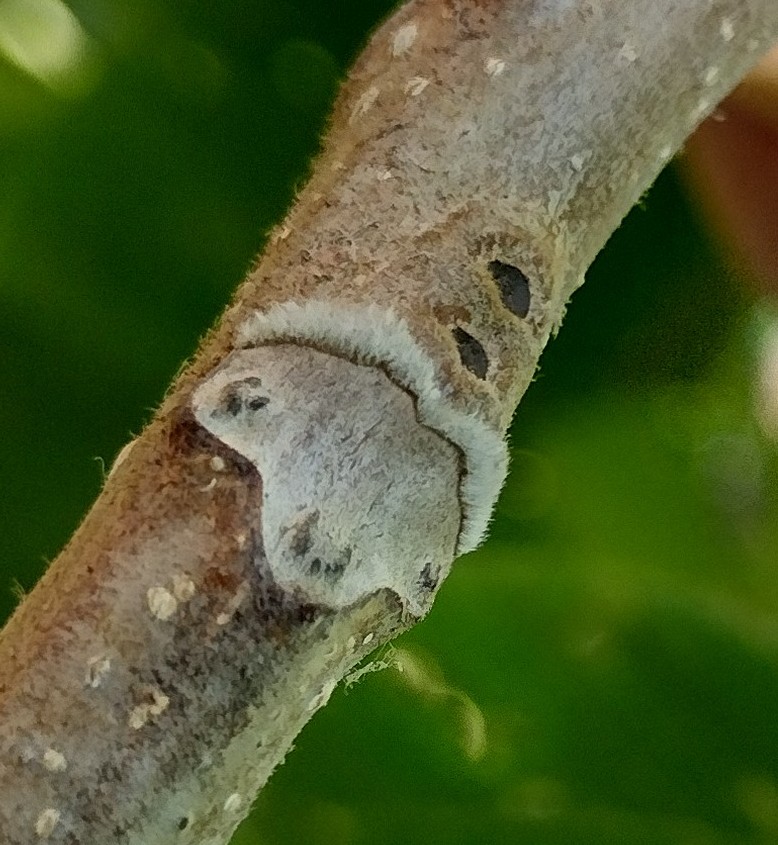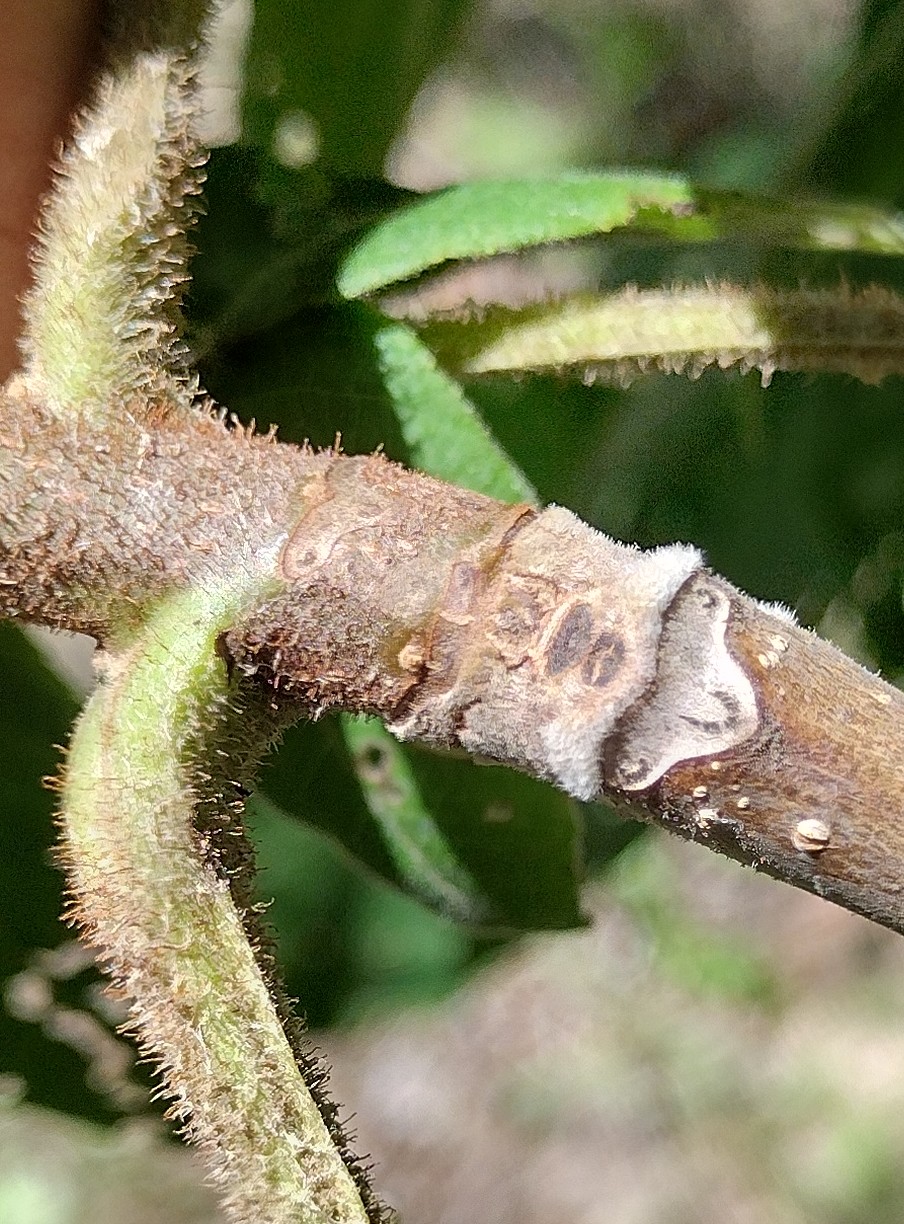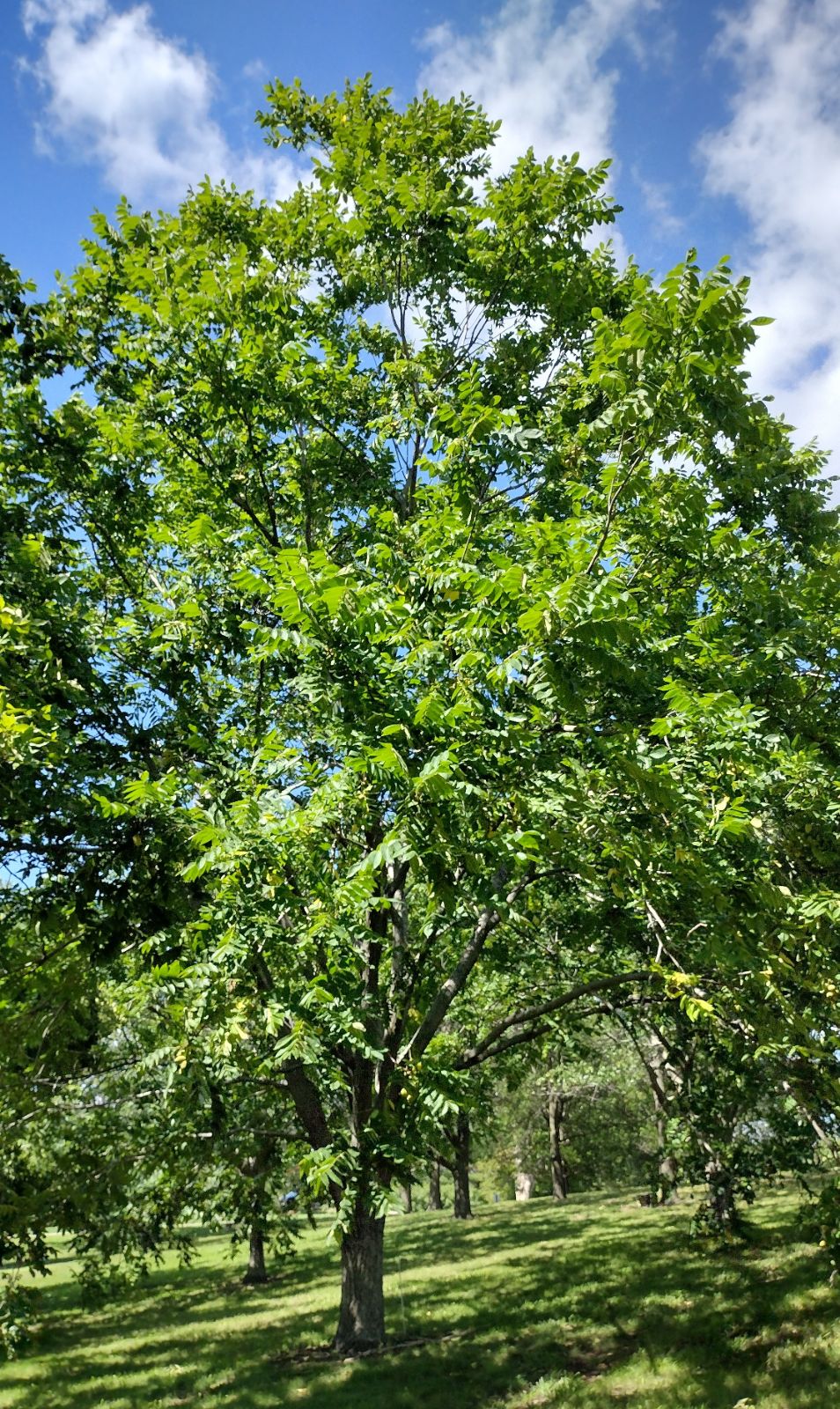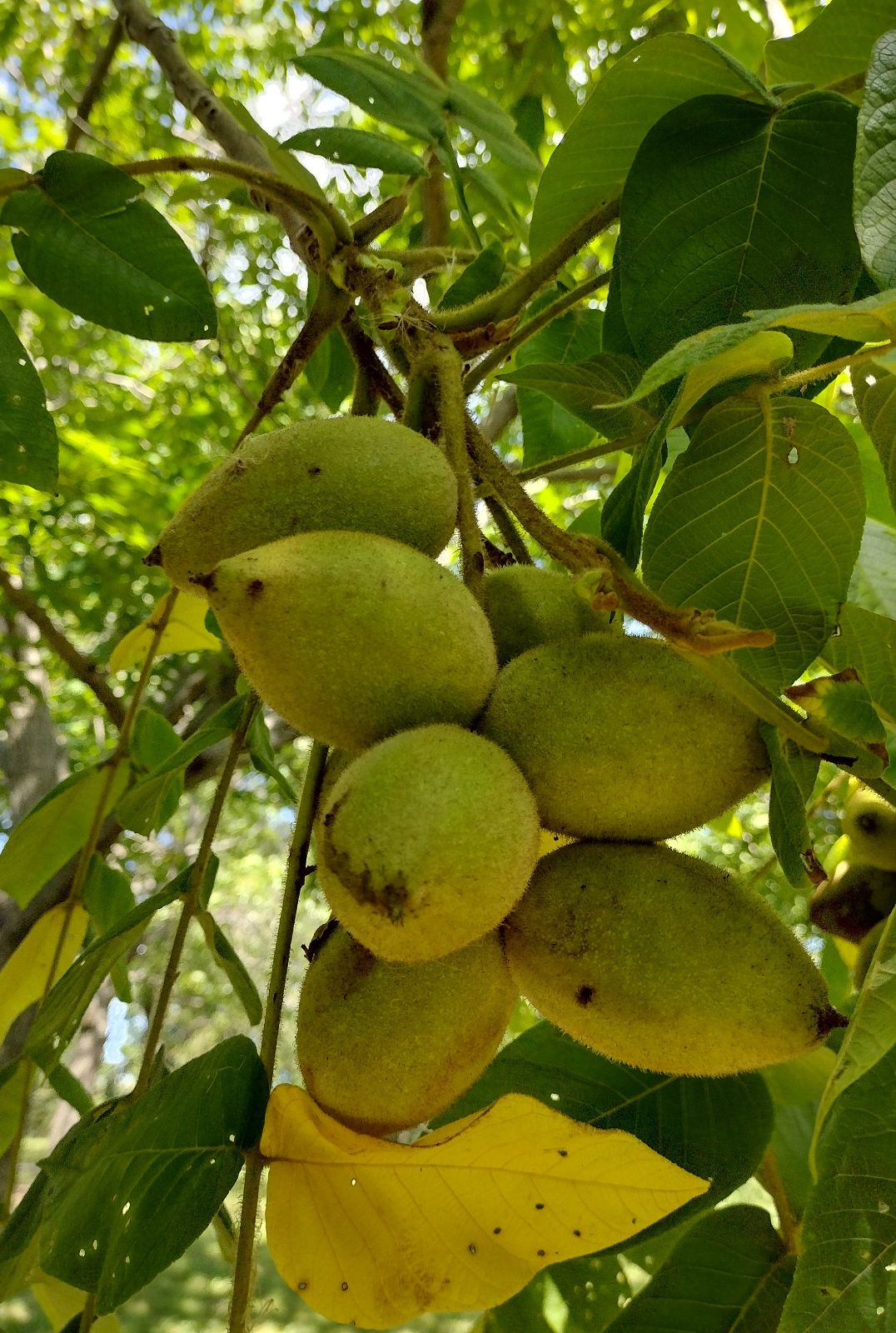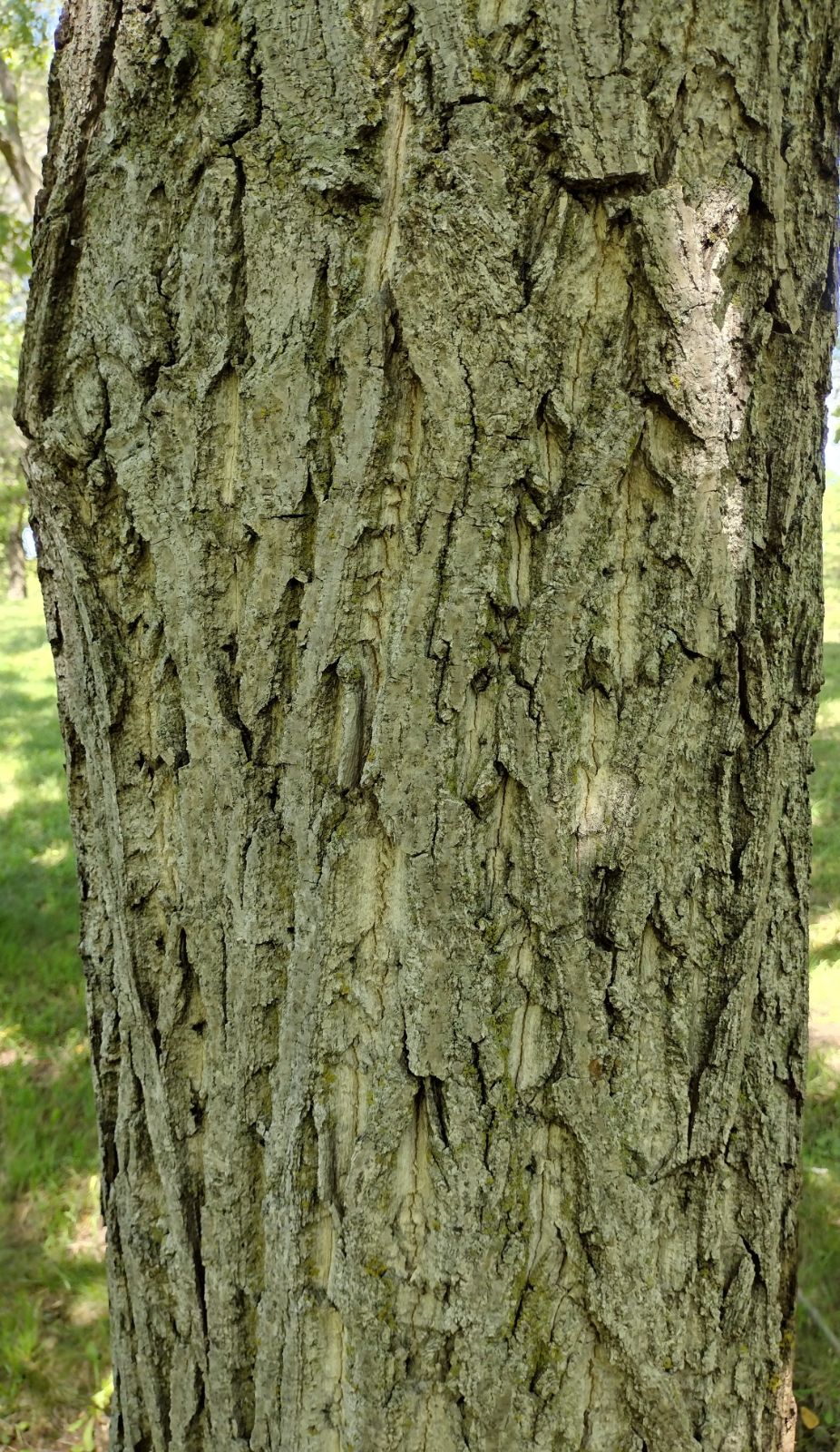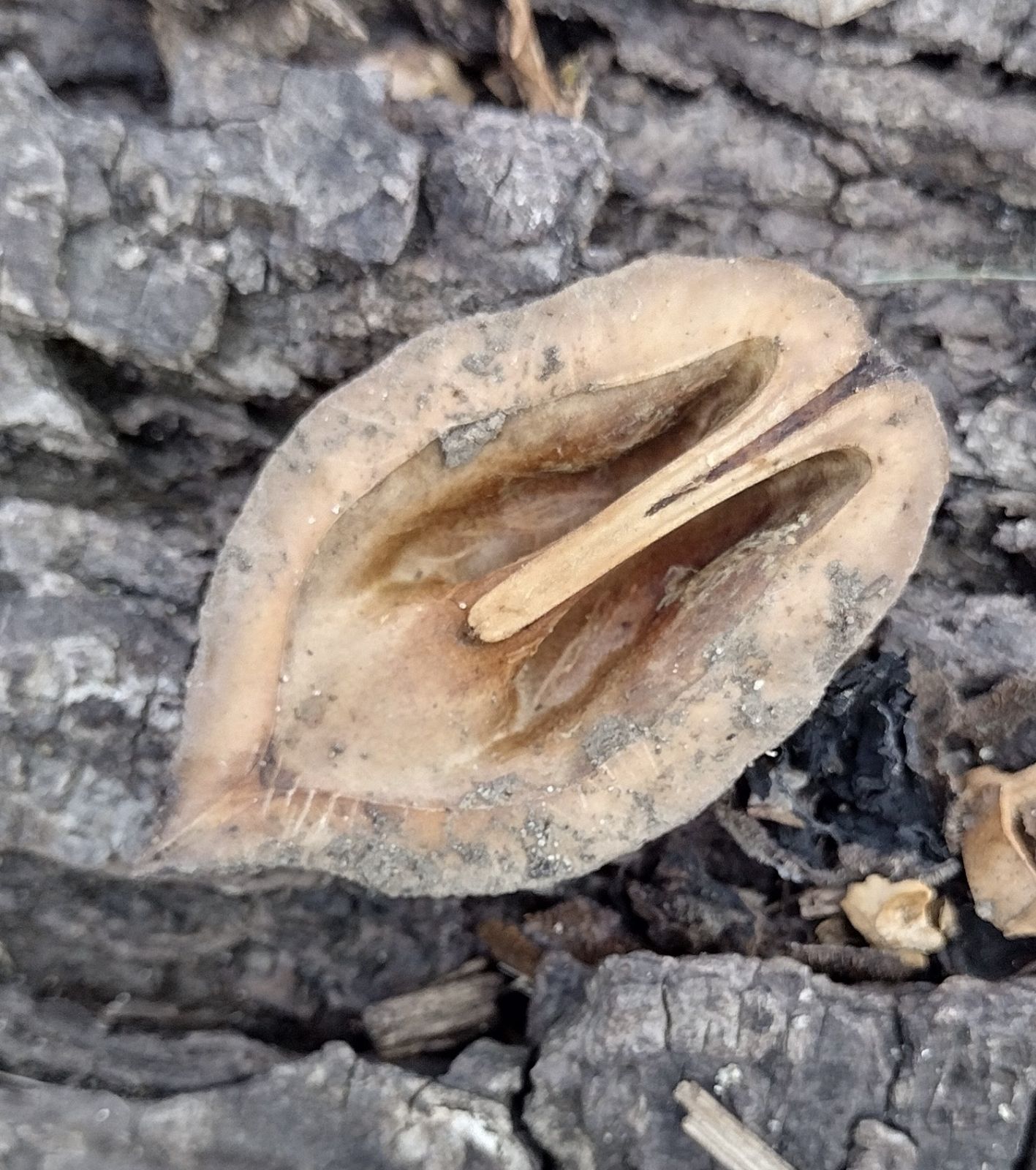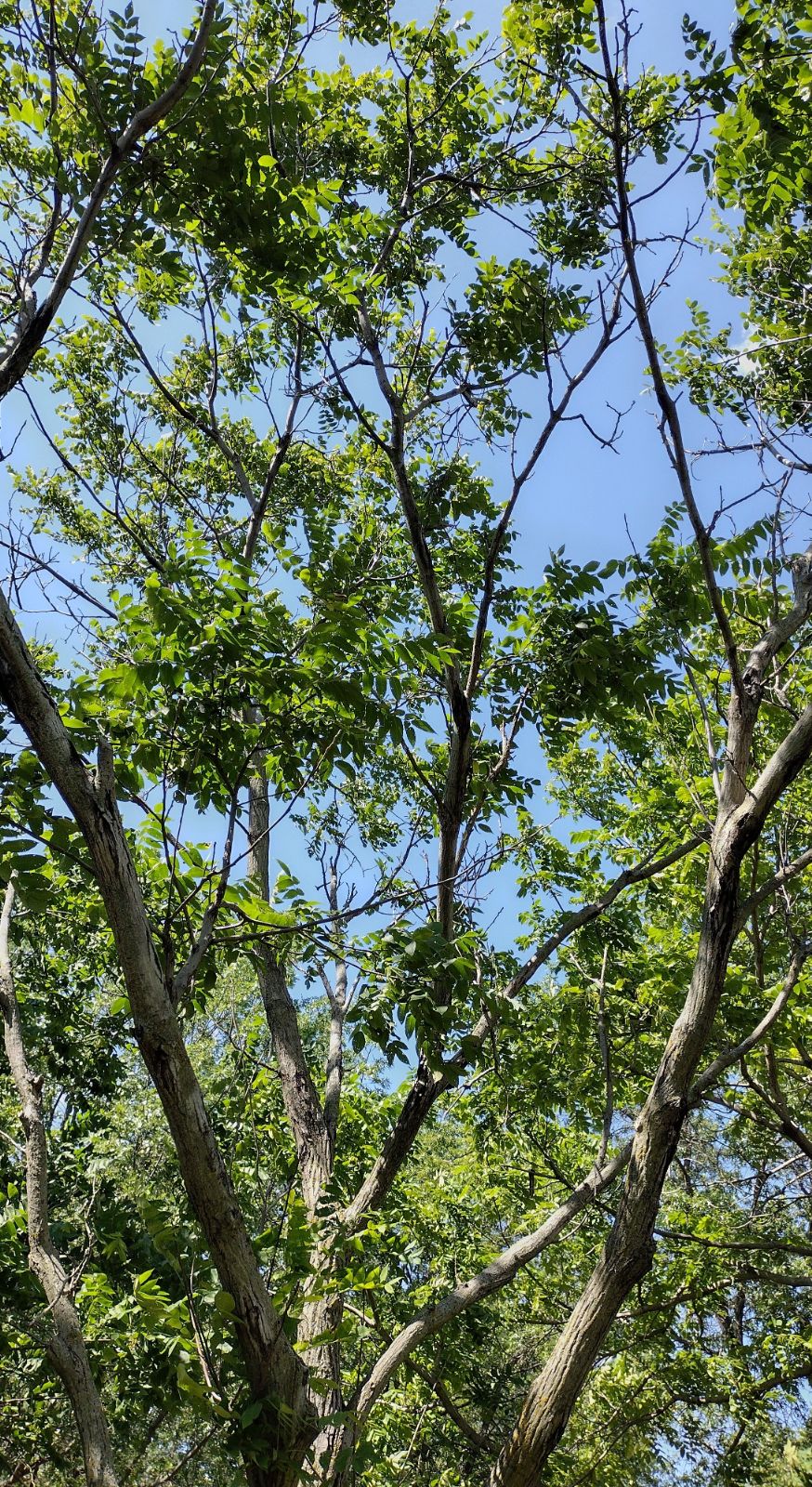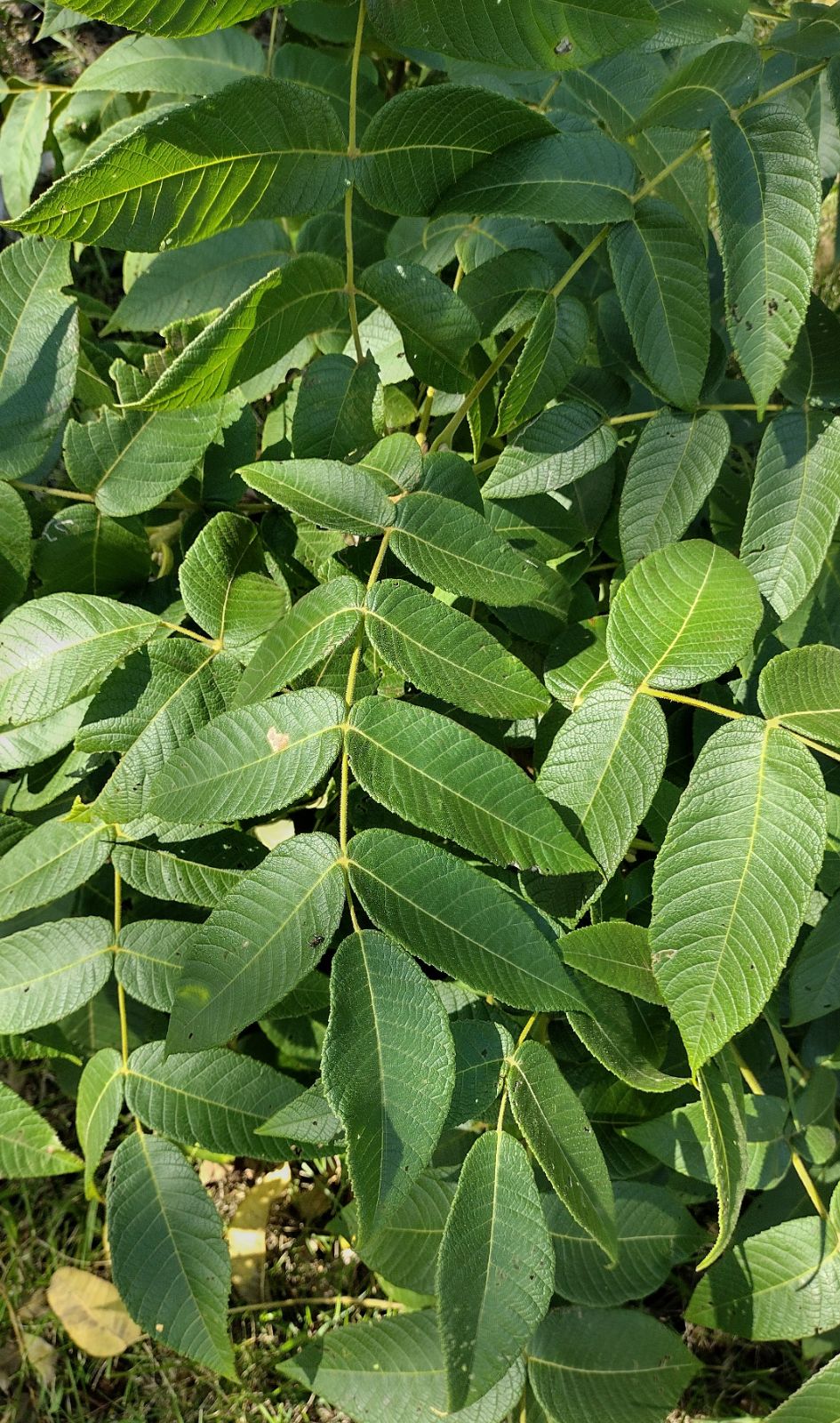Juglans cinerea
Sponsor
Kindly sponsored by
a member of the International Dendrology Society
Credits
Julian Sutton (2019)
Recommended citation
Sutton, J. (2019), 'Juglans cinerea' from the website Trees and Shrubs Online (treesandshrubsonline.
Genus
Common Names
- Butternut
- Oilnut
- White Walnut
- Noyer Cendré
Infraspecifics
Other taxa in genus
- Juglans ailantifolia
- Juglans × bixbyi
- Juglans californica
- Juglans cinerea × mandshurica
- Juglans hindsii
- Juglans hirsuta
- Juglans × intermedia
- Juglans major
- Juglans mandshurica
- Juglans mandshurica × regia
- Juglans Mexican Species
- Juglans microcarpa
- Juglans mollis
- Juglans nigra
- Juglans × notha
- Juglans olanchana
- Juglans Paradox hybrids
- Juglans pyriformis
- Juglans × quadrangulata
- Juglans regia
- Juglans sigillata
- Juglans × sinensis
- Juglans steyermarkii
Medium to large tree, to 20(–30) m. Bark light grey or grey-brown, shallowly divided into plates. Branchlets with dense felt of red-brown hairs at first; upper margin of leaf scar straight or nearly so, bordered by well-defined, tan-gray, velvety ridge; pith dark brown. Terminal buds conic, flattened, 12–18 mm. Leaves 30–60 cm; petiole 3.5–12 cm; terminal leaflet present, usually large. Leaflets (7–)11–17, ovate to lanceolate, scarcely curved, (2.5–)5–11(–17.5) × 1.5–6.5 cm; margins serrate, apex acuminate; upper surface with scattered fasciculate hairs, at least initially; lower surface with abundant 4–8-rayed fasciculate hairs, scales and sometimes glandular hairs, axils of main veins with prominent tufts of hair, the overall effect being a slightly greyish cast. Male catkins 6–14 cm; stamens 7–15 per flower. Fruits 3–5, ellipsoid to ovoid or cylindric, 4–8 cm, smooth, with dense glandular hairs; nuts ellipsoid to subcylindric or ovoid, 3–6 cm; surface with about 8 high, narrow, major longitudinal ridges, with further narrow, broken ridges or lamellae between them. Flowering April–June in natural range (Bean 1981; Whittemore & Stone 1997; Grimshaw 2004).
Distribution Canada New Brunswick, Ontario, Quebec; declining. United States From central Iowa and central Minnesota eastwards, largely absent from the South; declining.
Habitat Rich woods on river terraces and in valleys, also dry rocky slopes.
USDA Hardiness Zone 3-4
RHS Hardiness Rating H7
Conservation status Endangered (EN)
A century ago, the Butternut was a well known, widespread and economicaly significant tree of eastern North America. Today it is endangered by emergent disease, hybridisation with an alien species and habitat change (IUCN 2018). In cultivation outside North America it is surprisingly tricky to identify and much confused.
Over much of its range Juglans cinerea coexists with J. nigra. Hybrids between the two have occasionally been suspected, but never confirmed (Farlee et al. 2010). It is a smaller, shorter-lived tree than the Black Walnut; nut growers suggest that 75 years is a typical lifespan (Crawford 2016). The bark, lighter in colour than that of Black Walnut, is overall ash-grey giving rise to Linnaeus’ specific epithet, from the Latin cinereus (ashy). The foliage is strikingly sticky-hairy in comparison with J. nigra, and the leaf scars are distinctive. The upper edge of each scar has a velvety band of hairs along the upper surface; this is sometimes likened to a moustache, and is absent from all other American species.
The evolutionary origin of J. cinerea has recently become clearer (Zhang et al. 2019). Phylogenomic analysis suggests that it is the result of massive introgression from a member of the J. mandshurica lineage into a member of the black walnut lineage, 0.6–0.9 MYA. Subsequent extinctions and shifts in range within the parent groups had obscured this origin. The Butternut has much in common with J. mandshurica, not least the hairy band above the leaf scar. The clearest single distinguishing feature is the upper edge of the leaf scar, straight or only very slightly indented in the middle in J. cinerea, deeply notched in J. mandshurica. Also, both axilliary and terminal buds are longer and thinner in J. cinerea. These two species hybridise freely; the hybrid with J. m. var. cordiformis in particular has been valued for its ‘buartnuts’ in North America since the 19th century. Hybrids are rife both in cultivation and in the wild, but their full extent has only recently been revealed, using molecular markers to test the value of morphological identification features (Ross-Davis et al. 2008; Farlee et al. 2010). These authors describe identification features in great and nuanced detail, but it is clear that if the leaf scar has a distinct notch it is not pure Butternut. They note that butternuts are not long-lived, allowing genes from the Asiatic species to infiltrate populations quickly: ‘there are few (if any) trees alive today that predate the introduction of Japanese Walnut to America’ (Ross-Davis et al. 2008).
Juglans cinerea is valued for its nuts, harvested from the wild in pre-Columbian times and later from cultivated trees. They are very oily, with a mild, buttery flavour. Baking and confectionary, especially the New England delicacy maple-butternut candy, are major uses; young fruits can be pickled (Crawford 2016). Trees tend to crop well every 2–3 years (Rink 1990). Native American peoples used the fruits and bark as a dye (Moerman 2019) and this tradition was continued by European settlers. Yellow to brown butternut colours were characteristic of some Confederate uniforms during the American Civil War, giving rise to southern soldiers being nicknamed ‘butternuts’ (Goodell 1984). The wood is soft, coarse grained and lacks the strength of Black Walnut; it has been used for furniture, interior fittings and firewood (Schultz 2003).
Butternut populations across the range have been severely affected by butternut canker, caused by the fungus Sirococcus clavigignenti-juglandacearum, perhaps introduced from Asia (Woeste & Pijut 2009). Mortality rates are high and regeneration by both seed and coppice shoots is low. Much research has gone into identifying resistant trees: many proved to be hybrids, whose greater resistance to the disease has accelerated their spread, but some resistant individuals of pure J. cinerea have been found (Woeste & Pijut 2009).
It is hard to be certain exactly when Butternut was introduced to Europe, but most writers (for example, Elwes & Henry 1906–1913; Jacobson 1996) agree it was around the mid-17th century: Loudon (1838) records that it was being grown by the Duchess of Beaufort in 1699. It seems never to have been common, and venerable specimens are vanishingly rare. One such, apparently persisting through coppice regrowth, survives in the Victorian garden of Lower Coombe Royal, Kingsbridge, Devon (13 m × 130 cm, 2017). Another large tree (24 m × 130 cm, 2017) attributed to this species is at Cliveden, Buckinghamshire (The Tree Register 2019). This is a hardy tree; a few notable specimens are reported from across Europe as far east as Poland; north to northern Germany and southern Finland; and south to northern Italy (monumentaltrees.com 2019; Arboretum Mustila 2019). It should be stressed that none of these large individuals has been examined for this account, and identifications are taken on trust. Soberingly, Grimshaw (2004) concludes that few of the trees labelled J. cinerea in British collections are correctly named. Even recent accessions of wild origin should be approached with an open mind, given the prevalence of unrecognised hybrids.
In North America the Butternut and its hybrids have usually been grown for their nuts rather than as ornamentals. A number of J. cinerea cultivars have been bred in North America, although canker susceptibility makes hybrids more attractive nowadays. The following pure butternut cultivars are available in North America and sometimes in Europe as grafts or somewhat variable seedlings. Protogynous and protandrous cultivars should be grown together to maximize fertility. For further cultivar information see Crawford (2016). Note that cultivars may not be immune from the prevailing confusion: when two grafted specimens of the cultivar ‘Craxeze’ in the National Plant Collection of Juglans at Upton Wold, Gloucestershire were compared, one had typical Butternut leaf scars while those of the other were notched (pers. obs. 2019). At the Grimo Nut Nursery, Ontario all butternut stock has been DNA tested to ensure that hybrids are not inadvertently distributed (Grimo Nut Nursery 2019).
'Bear Creek'
Protandrous, with medium-sized nuts; the kernel tends to come out in halves. Productive but tending to crop biennially. Origin Iowa, suitable for zones 5b–8 (Grimo Nut Nursery 2019).
'Beckwith'
Protogynous, with medium-sized nuts that crack well. This is the most regular cropper of the varieties grown at the Grimo Nut Nursery near Niagara Falls, Ontario. Resistant to walnut leaf blotch. Origin New York State, hardy zones 5a–8 (Crawford 2016; Grimo Nut Nursery 2019).
'Bountiful'
'Craxezy'
A high yielding, early leafing variety whose medium-sized nuts crack especially well, hence the name. It has some resistance to walnut leaf blotch (Crawford 2016). Origin Michigan.
'Iroquois CA'
Protogynous; not selected for nut qualities so best as a forest or landscape tree. Selected for butternut canker resistance, from Iroquois Conservation Authority land near Ottawa, Ontario. Suitable for zones 5b–8. (Crawford 2016; Grimo Nut Nursery 2019).
'Kenworthy'
Protandrous, a moderately productive smaller tree but with very large nuts. Resistant to walnut leaf blotch. Origin Minnesota. Suitable for zones 5b–8 (Crawford 2016; Grimo Nut Nursery 2019).

